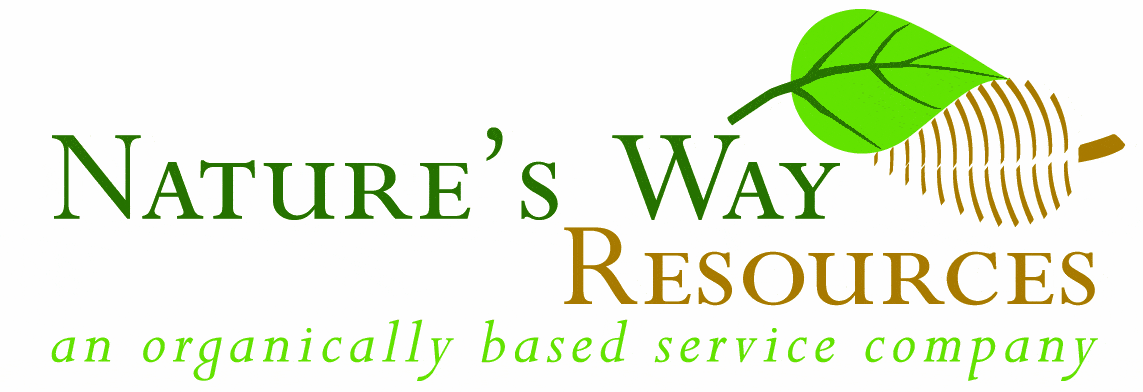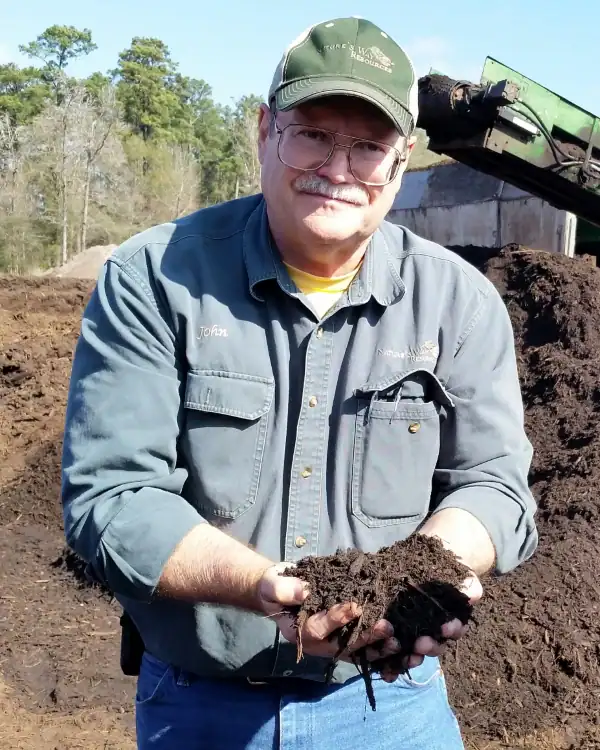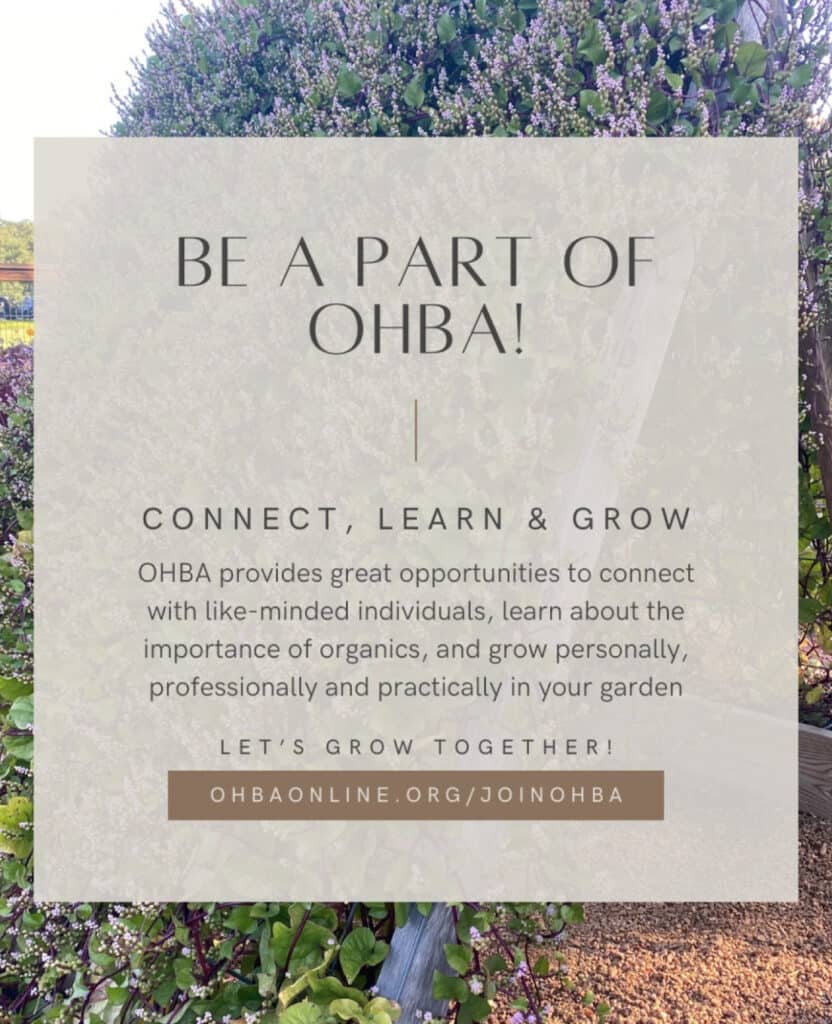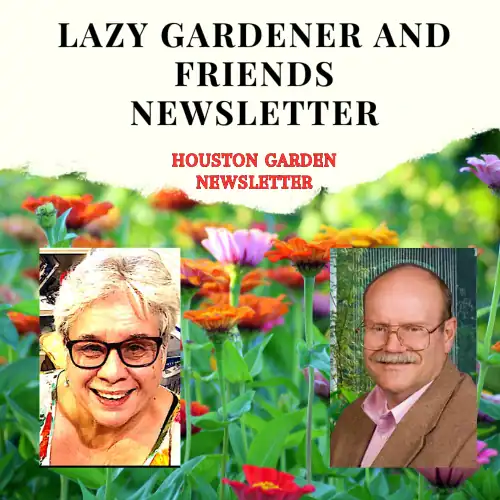
Nature’s Way Resources is proud to produce & email you this free weekly newsletter. We have no ads, but sponsors do graciously help support this project as a public service. Please note their names below & show your gratitude for this free service by patronizing their businesses! To become a sponsor, call (936) 273-1200
Nature’s Way Resources owner John Ferguson, “The Lazy Gardener” Brenda Beust Smith, and Shelby Cassano welcome your feedback and are so grateful to the many horticulturists who contribute their expertise
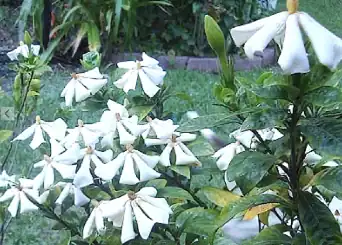
My late, great Rosedown Gardenia. So glad I photographed!
PROTECT YOUR GARDEN MEMORIES!!
by Brenda Beust Smith | The Lazy Gardener
Hard to believe it’s almost October. If you’re younger than I am (82), take my warning: One day you’ll look back and wish you’d done more to protect memories of your favorite garden successes. Since “fall” seems to pass faster than any other season here, now’s the time to immortalize your current fall successes!
Above is one of mine, a “Rosedown gardenia” Sadly, I lost her in Harvey and have never been able to replace her. Just like thousands of other Texas gardeners who have, hopefully still do, enjoy treasured plants brought to market by Smith County Extension Agent Greg Grant. This plant came into my life when I was thrilled to be invited to be on a podium at a horticultural meet with him back in the ’70s+/- in, yes, the namesake Louisiana town of Rosedown, LA. That’s where I bought mine (pictured above). It thrived for decades, with its incredible fragrance really filling the air. Hurricane Harvey took it away.
SO grateful I have this picture. Periodically I search for another one but always get hit with the same response: “Out of stock,” “Sold out,” etc. Hoping Greg sees this and lets me know where I can find another one! (But be grateful to hear from anyone!)
Lots of gardenias around, but this one has a unique flower and it survived my total neglect for more decades than I can remember. Since I’ve opened this book, know you can get a good look at many of Greg‘s 100+ other treasured introductions can be seen at Stephen F. Austin University’s world-recognized multiple gardens in Nacogdoches, Texas. It’s a treasure year-round but a wonderful place to see what incredible bloom explosions we have in fall.
HOLLY J., a (new-from-up-nawth) Houston area gardener wrote that she’s very confused about planting now. Do we or do we not have winters down? We do, and we don’t. Might be almost 0º or it might be in the 80º’s in “Fall” and sometiimes freezing north of downtown and short sleeve weather just a bit further south. Maybe this will help, Holly. It’s the October garden sketch in my Lazy Gardener’s Guide. (PDF, free)
The “genius loci ” was the protective spirit of a place “. . . harmonious connections to history, geography, local culture. . .?” and much, much more. What fun!
Professional landscapers are probably smiling at my naivety, but we lazy gardeners don’t sweat that sort of thing. We plant and hope all are happy enough to root ‘n’ grow! Yet this concept is a delight and made my gardening more fun.
To find the “Genies of YOUR place,” consider these key points:
- What are unique characteristics and spirit of YOUR landscape (think of whole place, not just one garden spot)? What do people notice/comment on when viewing your property for the first time?
- What about your garden is MOST important to you? Make you smile? Remind you of favorite places, people, or events? Attracts wanted wildlife into your life? Makes you proud?
- Does your yard “fit in” with surrounding natural environment? Do you want it to? Or rather it ‘stands out.’
- Is it Nature-friendly? Are you ok with whatever you answer?
No right or wrong answers. It’s what’s in YOUR head, YOUR heart (and won’t bring HOA knocking on your door, of course).
Tried this on my yard, and all I could come up with is “this” ____ makes me smile . . . or . . . wish “that” ____ would go away.” Can’t have things 100% all the time! But hope your “Genius of the Place” musings help make easier difficult decisions on what to put where! Who else would tell you these things?
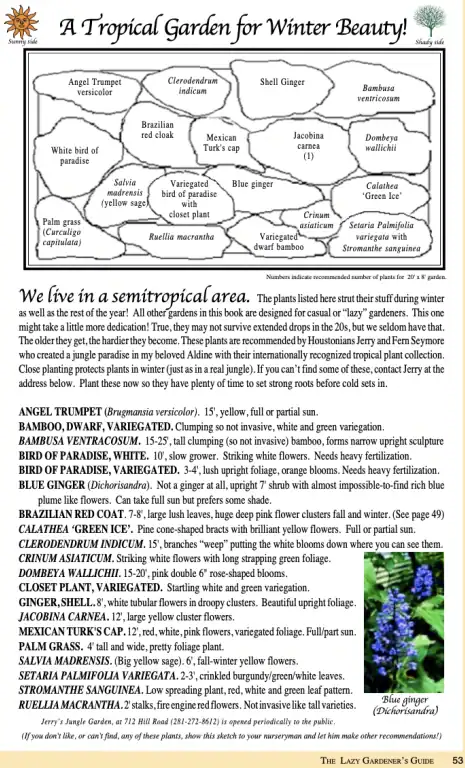
* * *

ATTN. GARDEN/PLANT GROUPS
— Nature’s Way Resources offers free guided tours of NWR’s extensive nursery/soil/mulch facilities for garden clubs, plant societies and other plant-oriented, organized groups. As usual, NWR’s now-expanded meeting site is free to above groups. Reservations a must for both. Great time to visit.

Submitting a Calendar Event?
For best chance of getting it in next upcoming newsletter, submit in exact requested format (see top of calendar below. Reformatting by us may = delay in publication)
John’s Corner
NEWS FROM THE WONDERFUL WORLD OF SOIL AND PLANTS
Subject: Soil Health
With fall upon us and the start of the fall planting season, let’s think about our soil as our gardens are only as good as the soil the plants grow in.
After working with gardeners all over southeast Texas for the last 40 years, lack of soil care or improper soil care is behind almost every problem a gardener encounters, from weeds to insects and disease.
All plant and animal life on earth depends on the soil. The soil on earth functions as our kidneys, stomach, and intestines do for us. It breaks down toxic substances, filters the air and water, stores carbon, provides nutrition, moderates temperature and many more eco-system services.
Our health is directly tied to the elements and nutrients in the soil. If they are not in the soil, the soil life cannot release them in a form for microbes and roots to absorb. Plants obtain these nutrients from the soil, animals acquire them when they eat the plants, and we get them from the plants and animals we eat. If these are not in the soil, then they are not in our food.
So, what is healthy soil?
It is a mix of sand, silt, clay and some other minerals with some quality organic matter like humus mixed in. It includes the microbial content, the air, water, and the available nutrients (elements) from the minerals.
In the last 20 years as our understanding of the tremendous importance of soil life, especially microbiology and the role it plays in plant growth and health has changed, it has caused our understanding of healthy soil to change.
As in medicine, the first step to getting healthy soil is to do no harm (quit destroying it). Toxic chemicals from pesticides and herbicides to artificial fertilizers destroy the soil. Even cultural practices like tilling destroy the soil by killing the life in the soil.
The second step is to nourish and replenish our soil. We need to ensure that our soil is a combination of the components below:
Organic matter from almost fresh to totally decomposed in the form of humus (humins, humic acid, fulmic acid, and ulmic acids)
Minerals (nutrients, sand, silt, and clay), elements in the soil major, minor, trace, micro, and we are now learning that even a few parts per billion (pico) affect plant, animal and human health.
Soil life that includes microbes (ex. bacteria and fungi), macrobes (earthworms, beetles, microarthropods, etc.).
Air & water (includes the chemicals dissolved in them, whether good or bad)
1) Organic matter (humus) is formed by the decomposition of plant wastes like leaves and twigs, animal waste like manure, dead bodies of animals, insects, microorganisms and root exudates. In general humus is the mythical and elusive dark brown to almost black substance that does not dissolve in water easily but can hold over 15 times its weight in water. It is a major component of good quality compost and helps give compost the dark chocolate brown to almost black color. Humus is the source of food and energy supporting most soil dwelling life forms.
2) The mineral requirement in a soil for healthy plant growth is a subject that is constantly being changed and expanded every year. First it was assumed that plants only needed the elements NPK (nitrogen (N), phosphorous (P), and potassium (K)) which are known as the “macro-nutrients”.
Later it was discovered that calcium (Ca), magnesium (Mg), manganese (Mn), iron (Fe), copper (Cu), and sulfur (S) were also required. Over the last 25 years research has shown that zinc (Zn) and a little sodium (Na) were essential. Research over the last 10 years has shown that boron (B) is essential. These are often called minor nutrients.
There are about 90 elements naturally found in the earth’s crust and in seawater, hence we still have dozens of elements to go.
What about aluminum (Al)? The synthetic fertilizer industry says it is not required by plants. However, when plant tissue is chemically analyzed, aluminum is present in small amounts. Other tests have shown that some plants grown in soils without aluminum will die, while other tests have shown plants without aluminum are disease prone and are subject to higher rates of insect damage.
What about cobalt (Co)? Most gardening and agricultural books say it is not required by plants. However, the vitamin B-12 molecule which regulates the immune system of mammals (including humans) requires cobalt. The element cobalt is also essential for hemoglobin formation, and for the prevention of nerve degeneration.
Why is this important?
For us as people who consume food to obtain minerals, the mineral (element) must be in the food we eat. This means it must be in the plants, which means it must be present and available in the soil for microbes to build the B-12 molecule and for plants to absorb. NO cobalt in the soil means NO vitamin B-12 in our food.
Recently it has been discovered that cobalt is needed in legumes for nodule formation and nitrogen conversion, seeds started without cobalt in the soil will not grow into a viable plant. It has also been found in the bodies of microorganisms that live in the soil. Is it important?
How about Selenium (Se)? This element is not generally thought of as a plant nutrient. However, it is important in protecting humans against chronic degenerative diseases as it is required in the production of powerful antioxidants such as vitamin E and glutathione peroxidase. Medical studies have found that America’s “Stroke Belt” runs right across America where selenium content in the soils is low. Is selenium important? – You bet it is.
How important are these other elements?
Studies have shown that people who live in igneous areas with highly mineralized soil and water, the Hunza’s, the Vilcabamba’s, etc. have life spans averaging 127 years old, without the aid of medical technology.
Current theory, confirmed by animal tests, indicates the presence of all the trace and micro amounts of minerals in the water and soil where they live allows the human body to work more efficiently to repair itself, prevent disease, and slow down the aging process.
Over 700 human health problems are caused or aggravated by a lack of elements in our food supply. Seventy-nine elements have been found in animal and human tissue. So why are these elements there? Does God make mistakes?
Modern soil scientists researching organic and biological methods take the position of having all the possible elements present in the soil and then letting the plants and microbes take what they want and need. A process known as re-mineralizing the soil.
These trace elements are found in rock dusts like granite and basalt sands, products from the ocean (seaweed and fish emulsions), green sand or glauconite and a few other mined products.
Note: Nature’s Way Resources, “Re-Mineralizer” is a blend of greensand, granite sand and basalt sand to ensure all the elements are there and so gardeners do not have to worry about three separate products to remineralize their soil.
3) Today we know the biology of the soil is many times more important than physics and chemistry combined! If we get soil biology working correctly, biology will tend to fix the physics and chemistry issues, given the correct resources.
Biology is important consideration of a healthy soil. It is the most important, the most frequently neglected, and the most easily destroyed. One pound of healthy soil, barely a double handful, will contain over 9 billion microbes. Not millions but billions, and some studies are now suggesting trillions of microbes in a pound of real healthy soil!
As these microbes live and grow, they break down rock minerals releasing nutrients. Many of these microbes can obtain nitrogen from the air which is then assimilated into their bodies in the form of proteins, enzymes, amino acids, vitamins, etc. all which are beneficial to plants, insects, wildlife and ultimately humans.
In addition to the army of microbial workers we also have the macrobes. These include earthworms, beetles, centipedes, ants, arthropods, burrowing frogs, etc. These animals churn and till the soil increasing the porosity and tilth. This burrowing action has been found to stimulate root growth in most plants.
Of this group earthworms are the most valuable and a gardener’s best friend. Many species of earthworms eat pathogenic species of bacteria and fungi. They also produce powerful plant growth hormones called auxins. It is in their castings, and it is in the mucus that they line their tunnels with. If one has a healthy population of earthworms, you will never need to mechanically aerate your soil.
The whole model of how soil health and fertility works is known as “The Soil Food Web.”
4) For the soil to breathe, there must be pore spaces air and channels that air can flow, sort of like air conditioning ducts in our house, a characteristic we call permeability. As the temperature of the air and of the soil changes during the day and night, air enters or leaves the soil.
Additionally, the carbon dioxide (CO2) produced by the respiration of microbes and other soil life and the breakdown of the carbon stored in the organic matter needs to escape the soil and let oxygen back into the soil or the good and beneficial life dies.
Water is stored in the soil in several ways. First it is bound chemically by the clay and humus in the soil, next it is stored as a film or coating on soil particles and last it is stored in the void or interstitial spaces between grains of soil.
Our largest storage vessel for water is the soil. A soil with only 3% organic matter by weight will have a 60% porosity. If 35% of this pore space is air and 25% is water, then the soil will hold over 120,000 gallons of water per acre in the top 18 inches of soil. A real healthy soil will have over 8% organic matter and go down several feet!
REFERENCES:
“Dirt: The Erosion of Civilizations” by David Montgomery, ISBN 978-0-520-24870-0
For those who want to know more about the importance of soil care, the book below explains that every civilization in history failed because they did not take care of their soil.
Teaming with Microbes, A Gardener’s Guide to the Soil Food Web, 2nd Edition, by Jeff Lowenfels & Wayne Lewis, Timber Press, 2006, ISBN-13:978-0-88192-777-1
A great introduction to the importance of soil life and how it relates to our health for beginners.
The power of rock dusts (ground up rocks) benefits the entire world-wide ecosystem hence an organization has been formed to help educate folks on the benefits of rock dusts and the minerals they contain called “Remineralize The Earth.”
Click below to learn more about all of the different types of mulch in detail.
Explore our article library to learn more information about various mulches and other topics.
Sponsorship
If you are interested in becoming a sponsor, please contact us at 936-273-1200 or send an e-mail to: lazygardenerandfriends@gmail.com
About Us
BRENDA BEUST SMITH
WE KNOW HER BEST AS THE LAZY GARDENER . . .
but Brenda Beust Smith is also:
- a national award-winning writer & editor
- a nationally-published writer & photographer
- a national horticultural speaker
- a former Houston Chronicle reporter
When the Chronicle discontinued Brenda’s 45-year-old Lazy Gardener” print column — started in the early ’70s as a fun side-project to reporting, it then ranked as the longestrunning, continuously-published local newspaper column in the Greater Houston area. The name, she says, is not just fun, it’s true.
Brenda’s gradual sideways step from reporter into gardening writing led first to an 18-year series of when-to-do-what Lazy Gardener Calendars, then to her Lazy Gardener’s Guide book which morphed into her Lazy Gardener’s Guide on CD, which she now emails free upon request.
Brenda became a Harris County Master Gardener and, over the years, served on theboards of many Greater Houston area horticulture organizations. She hosted local radio and TV shows, most notably a 10+-year Lazy Gardener specialty shows on HoustonPBS (Ch. 8) and her call-in “EcoGardening” show on KPFT-FM.
For over three decades, Brenda served as Assistant Production Manager of the GARDEN CLUB OF AMERICA’S “BULLETIN” magazine. Although still an active broad-based freelance writer, Brenda’s main focus now is THE LAZY GARDENER & FRIENDS HOUSTON GARDEN NEWSLETTER with John Ferguson and Pablo Hernandez of Nature’s Way Resources.
A native of New Orleans and graduate of St. Agnes Academy and the University of Houston, Brenda lives in Humble, TX, and is married to the retired Aldine High School Coach Bill Smith. They have one son, Blake.
Regarding this newsletter, Brenda is the lead writer, originator of it and the daily inspiration for it. We so appreciate the way she has made gardening such a fun way to celebrate life together for such a long time.
About her column, Brenda says: “I don’t consider myself a ‘garden writer.” I started out 50+ years ago as a very lazy “gardening reporter.” I still feel that way today. I hope my columns inspire/help newcomers, but I do not write to them. I write to very experienced gardeners who want to expand their horizons.
JOHN FERGUSON
John is a native Houstonian and has over 35 years of business experience. He owns Nature’s Way Resources, a composting company that specializes in high quality compost, mulch, and soil mixes. He holds a MS degree in Physics and Geology and is a licensed Soil Scientist in Texas.
John has won many awards in horticulture and environmental issues. For years he represented the composting industry on the Houston-Galveston Area Council for solid waste. His personal garden has been featured in several horticultural books and “Better Homes and Gardens” magazine. His business has been recognized in the Wall Street Journal for the quality and value of their products. He is a member of the Physics Honor Society and many other professional societies. John is the co-author of the book Organic Management for the Professional.
For this newsletter, John contributes articles regularly and is responsible for publishing it.
PABLO HERNANDEZ Pablo Hernandez is the special projects coordinator for Nature’s Way Resources. His realm of responsibilities include: serving as a webmaster, IT support, technical problem solving/troubleshooting, metrics management and quality control. Pablo helps this newsletter happen from a technical support standpoint.
Download the Newsletter with Our Events Calendar Below!

NATURE’S WAY RESOURCES
101 Sherbrook Cir.
Conroe, TX 77385
Hours of Operation
Monday – Friday: 8AM to 5PM
Saturday: 8AM to 2PM
Copyright © 2024 Nature’s Way Resources | All rights reserved.
